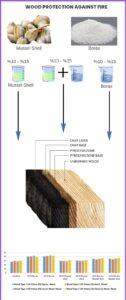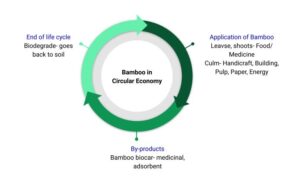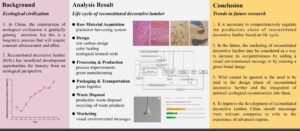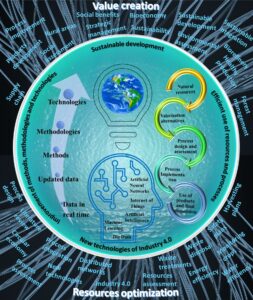Volume 17 Issue 3
Latest articles
- Researchpp 5319-5334Tan, H. (2022). "Crushed mussel shell powder and optional borax in surface char layers to protect four wood species against fire," BioResources 17(3), 5319-5334.AbstractArticlePDF

The goal is to protect semi-finished/finished wood components from burning/fires in a variety of settings (wooden buildings, historical sites, restoration, etc.). Natural (organic) sea mussel shells (Chamelea gallina) were crushed and prepared with water in various solution concentrations (10%, 15%) after the pyrolysis process, either alone or together with boron compounds (borax). The limiting oxygen index value (LOI) was determined by making retention calculations. Coatings were applied to the wood as a double treatment, with boron compounds (borax) used for comparison purposes. Eastern spruce (Picea orientalis (L.) Link.), Anatolian chestnut (Castanea sativa Mill.), eastern beech (Fagus orientalis Lipsky), and locust (Robinia pseudoacacia) were chosen for this research. When the pyrolysis-treated impregnated samples were compared to the pyrolysis-treated control sample, the limiting oxygen index value (LOI) was found to be significantly higher in the impregnated samples. After impregnation, 15% borax (0.89%) in acacia wood had the highest retention value, whereas 10 percent mussel shell (0.22%) in spruce wood had the lowest. The maximum limiting oxygen index value (LOI) was found in acacia wood (42.8%), while the lowest value was found in acacia wood (28.9%) impregnated with 10% mussel shell powder after the pyrolysis process.
- Researchpp 5335-5348Hamdan, S., Rahman, M. R., Mohamad Said, K. A., Zainal Abidin, A. S., and Musib, A. F. (2022). "Sompoton: Sabah bamboo mouth organ," BioResources 17(3), 5335-5348.AbstractArticlePDF
This study considered the Sabah traditional bamboo musical instrument, sompoton. The fast Fourier transform (FFT) of sompoton was determined via a Pico oscilloscope. All three sompotons displayed almost similar fundamental frequencies. The individual tubes 1, 2, 3, 4, 5, 6, and 8 (except tube 7) of sompoton I, II, and III produced the fundamental frequency (in hertz) as 924, 758, 655, 589, 449, 407, 537, as 954, 779, 655, 614, 469, 387, 552, and as 944, 820, 655, 635, 407, 407, and 552, respectively. The averaged frequency obtained from the three sompotons (with the diatonic frequency and note in bracket) was 940.6 (932.3-A5# tube 1), 785.6 (783.9-G5 tube 2), 655 (659.2-E5 tube 3), 612.6 (622.2-D5# tube 4), 547 (554.3-C5# tube 8), 441.6 (440-A4 tube 5), and 400.3 (392-G4 tube 6). The tunings were remarkably similar in the tonal relationships. The pitch of the drone tube (tube 6) repeated an octave higher at tube 2, the intervals of perfect 4th higher at tube 8, and the intervals of perfect 5th higher at tube 4 were always found. The standard deviations of the fundamental pitch from the three sompotons for tube 1, 2, 3, 4, 5, 6, and 8 were 15.3, 31.5, 0.0, 9.2, 31.6, 11.5, and 8.7, respectively.
- Researchpp 5349-5371Świderski, B., Antoniuk, I., Kurek, J., Bukowski, M., Górski, J., and Jegorowa, A. (2022). "Tool condition monitoring for the chipboard drilling process using automatic, signal-based tool state evaluation," BioResources 17(3), 5349-5371.AbstractArticlePDF
An automatic approach to tool condition monitoring is presented, with the best solution achieving overall accuracy of 94.33% and 9 misclassification errors. In the wood industry, cutting tools need to be evaluated periodically. This is especially the case when drills are concerned; since when dulled, the resulting poor-quality product may generate loss for the manufacturing company, due to the need to discard it during quality control. Each tool can be classified either as useful or useless, and the second type should be exchanged as fast as possible. Manual evaluation of tools is time consuming, which results in production downtime. This problem requires a faster, automated, and precise solution for the work environment. In response to this issue, an ensemble algorithm was developed. Different signals were collected for the input data, including feed force, cutting torque, noise, vibrations, and acoustic emission. Based on those signals, a set of 152 initial features was generated, while after feature selection 19 of them were used by the classifiers. Different algorithms were tested and evaluated in terms of overall accuracy and number of errors. The best classifiers were used to prepare ensemble solution, which was able to classify the tools accurately, with very few errors between recognized classes.
- Researchpp 5372-5392Su, Y., Zou, J., and Lu, W. (2022). "Evaluating the ultimate bearing capacity of glued laminated bamboo hollow columns under eccentric compression," BioResources 17(3), 5372-5392.AbstractArticlePDF
To improve the utilization rate of bamboo, glued laminated bamboo hollow column (GLBHC) was examined under eccentric compression to study the effects of different slenderness ratios, eccentric distances, and wall thicknesses on its ultimate bearing capacity. The nonlinear deformation of the material and the P-delta effect of the column occur under eccentric compression, which can affect its ultimate bearing capacity, so it is very important to analyze the elastic-plastic buckling of the column. Moreover, the discontinuity of the hollow column section aggravates the nonlinear deformation. To accurately estimate the ultimate bearing capacity of GLBHC, considering the difference in tensile and compression elastic modulus, two eccentric compression models were established. A formula for ultimate bearing capacity of the GLBHC under eccentric compression was proposed, and the calculated results were in good agreement with the test results.
- Researchpp 5393-5419Ren, J., and Xiong, X. (2022). "Digital design process and part family division of solid wood custom cabinet door based on multi-attribute overlapping clustering technology," BioResources 17(3), 5393-5419.AbstractArticlePDF
The flexible production of solid wood custom furniture is needed to meet the individual needs of the market. Based on M Company, this study developed a digital design platform and its key technologies (data extraction and integration, part family division, coding technology, model base construction, information interaction, and connection) and proposed a multi-attribute overlapping clustering technology (MOCT) method for the division of a family of cabinet door parts. The results indicated that the platform and technologies based on M company provides a reference for the digital transformation of solid wood furniture. The part family division method based on MOCT displayed excellent grouping performance and adjustability, and it could be extensively applied to the group processing of solid wood furniture parts.
- Reviewpp 5420-5436Kumar, A., Bharti, A. K., and Bezie, Y. (2022). "Schizophyllum commune: A fungal cell-factory for production of valuable metabolites and enzymes," BioResources 17(3), 5420-5436.AbstractArticlePDF
Schizophyllum commune is a basidiomycete that is capable of producing different valuable metabolites such as schizophyllan-a polysaccharide, ethanol, and lignocellulolytic enzymes. Schizophyllan finds application in the food industry, pharmacy, and oil recovery. It acts as a non-specific stimulator of immune system. It shows bioactivities such as antineoplastic, antibacterial, anti-cancer, anti-inflammatory, and antiparasitic properties. S. commune is capable of producing bioethanol directly in a single step using lignocellulosic biomass. Lignocellulolytic enzymes including cellulase, xylanase, pectinase, laccase, lignin peroxidase, and manganese peroxidase, are also synthesized efficiently by different strains of S. commune. Being a good producer of ligninolytic enzymes, S. commune has been shown to be effective for the degradation of various synthetic dyes. This article reviews the production of schizophyllan, ethanol, and enzymes and the utilization of S. commune for lignocellulose degradation and decolorization of synthetic dyes.
- Reviewpp 5437-5463Kaur, P. J., Yadav, P., Gupta, M., Khandegar, V., and Jain, A. K. (2022). "Bamboo as a source for value added products: Paving way to global circular economy," BioResources 17(3), 5437-5463.AbstractArticlePDF

Bamboo biomass is known for its low cost, abundance, fast growth rate, low weight-to-height ratio, and load-bearing abilities, making it an attractive alternative to materials such as wood, metal, steel, and plastic for multiple applications. Bamboo is traditionally used in handicrafts, food, building, construction, pulp, and paper. The production of energy and green adsorbents with unique properties are a few emerging applications of bamboo. Porous structured, bamboo-based charcoal allows the separation of solute from solvent and can be used to detoxify the air, water, and soil. The surface functional groups can be enhanced during thermal processing, yielding activated carbon products and serving greenhouse gas capturing applications. Nanoparticle particles (Ni0.5Zn0.5Fe2O4 and silver) coated bamboo charcoal has shown microwave and Infrared energy shielding effects. Bamboo-based charcoal also has exceptional medicinal values, is an efficient drug-delivery agent, and has tremendous potential for small and medium enterprises. Bamboo charcoal is also investigated as a toxin adsorber and hence a blood purifier. This review also considers the potential and challenges in using bamboo and its products for many applications that can contribute to a renewable society.
- Reviewpp 5464-5484Zhou, C., Shi, Z., and Kaner, J. (2022). "Life cycle analysis for reconstituted decorative lumber from an ecological perspective: A Review," BioResources 17(3), 5464-5484.AbstractArticlePDF

In response to global Sustainable Development Goals (SDGs), the Chinese government has pledged to curtail increased carbon dioxide emissions beyond 2030 and to achieve carbon neutrality by 2060, thus achieving a status of an ecological civilization. Reconstituted decorative lumber, with rotary-cut (or planed) veneer from plantation or common species timber as the main raw material, has beneficial development opportunities for forestry from the perspective of an ecological civilization. This paper first discusses China’s current state of ecological civilization, then researches the various life cycles of reconstituted decorative lumber using the life cycle theory and provides a reference for the Chinese reconstituted decorative lumber industry’s development by analyzing progress in related fields. The eco-friendliness of reconstituted decorative lumber is explained via systematic combing, and proposals for the use and promotion of reconstituted decorative lumber in the new period are presented. Research and analysis findings show that it is necessary to comprehensively regulate the production chain of reconstituted decorative lumber based on life cycle. Research on the development and utilization of reconstituted decorative lumber needs to be strengthened. The promotion and marketing of reconstituted decorative lumber can be promoted by emphasizing its ecological significance.
- Reviewpp 5485-5509Zhou, Y., Xu, W., Pan, Y., Wang, F., Hu, X., Lu, Y., and Jiang, M. (2022). "Deep eutectic-like solvents: Promising green media for biomass treatment and preparation of nanomaterials," BioResources 17(3) 5485-5509.AbstractArticlePDF
Deep eutectic-like solvents (DESs) are recognized as environmentally benign media with highly tunable structures and properties. The usage of DES is promising in the field of biomass treatment and transformation, including pretreatment, selective dissolution, and separation of the main components. It serves as a green medium for modification of the biomass components, as well as preparation of biomass-derived nanomaterials. In this paper, the development on DES, including composition, properties, and characteristics was studied. The application of DES in biomass-derived nanomaterials is especially discussed. This review intends to provide references for adopting DES to improve biomass-based environmentally friendly nanomaterials.
- Reviewpp 5510-5531Clauser, N. M., Felissia, F. E., Area, M. C., and Vallejos, M. E. (2022). "Integrating the new age of bioeconomy and Industry 4.0 into biorefinery process design," BioResources 17(3), 5510-5531.AbstractArticlePDF

Manufacturing processes and their economy are dramatically evolving due to machinery and digital control improvements. Artificial intelligence, big data analytics, and the Internet of Things are key tools for this new industrial revolution era based on Industry 4.0. Bioeconomy and circular economy concepts have appeared in the forest, agriculture, food, pharmaceutical, pulp and paper, chemical, biotechnological, and energy areas, etc., to achieve sustainable economic growth development via biomass valorization in a biorefinery platform. Biorefinery process development at an industrial scale requires the previous design and assessment of processes and technologies. Therefore, economic, environmental, and social factors should be evaluated to prevent the failure in one of these issues that could affect the performance of the others. With a growing interest in sustainable economic development, there is a need to incorporate new technologies early enough in the process design. This study aims to better understand how Industry 4.0 era tools can bring new solutions to the biorefinery process design, in terms of the technical, economic, environmental, and social factors. Thus, these tools could improve and revolutionize the process selection optimization, provide alternatives for biomass valorization, integration strategies, and the metrics selection for process evaluation, adding the approach toward sustainable economic development.
